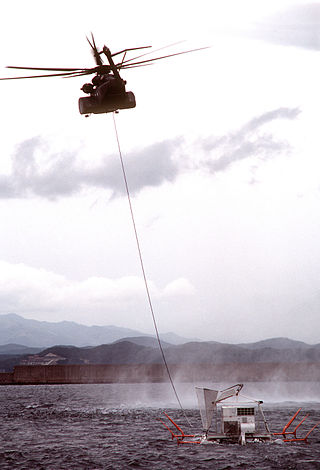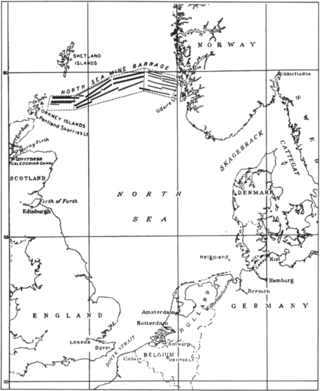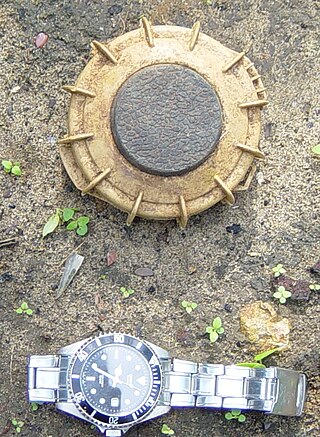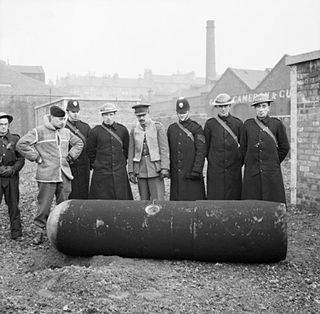
A land mine, or landmine, is an explosive weapon concealed under or camouflaged on the ground, and designed to destroy or disable enemy targets, ranging from combatants to vehicles and tanks, as they pass over or near it.

A naval mine is a self-contained explosive device placed in water to damage or destroy surface ships or submarines. Unlike depth charges, mines are deposited and left to wait until they are triggered by the approach of, or contact with, any vessel or a particular vessel type, akin to anti-infantry or anti-vehicle mines. Naval mines can be used offensively, to hamper enemy shipping movements or lock vessels into a harbour; or defensively, to protect friendly vessels and create "safe" zones. Mines allow the minelaying force commander to concentrate warships or defensive assets in mine-free areas giving the adversary three choices: undertake an expensive and time-consuming minesweeping effort, accept the casualties of challenging the minefield, or use the unmined waters where the greatest concentration of enemy firepower will be encountered.

Trinitrotoluene, more commonly known as TNT (and more specifically 2,4,6-trinitrotoluene), and by its preferred IUPAC name 2-methyl-1,3,5-trinitrobenzene, is a chemical compound with the formula C6H2(NO2)3CH3. TNT is occasionally used as a reagent in chemical synthesis, but it is best known as an explosive material with convenient handling properties. The explosive yield of TNT is considered to be the standard comparative convention of bombs and asteroid impacts. In chemistry, TNT is used to generate charge transfer salts.

A depth charge is an anti-submarine warfare (ASW) weapon designed to destroy submarines by detonating in the water near the target and subjecting it to a destructive hydraulic shock. Most depth charges use high explosives with a fuze set to detonate the charge, typically at a specific depth from the surface. Depth charges can be dropped by ships, patrol aircraft and helicopters.

A booby trap is a device or setup that is intended to kill, harm or surprise a human or another animal. It is triggered by the presence or actions of the victim and sometimes has some form of bait designed to lure the victim towards it. The trap may be set to act upon trespassers that enter restricted areas, and it can be triggered when the victim performs an action. It can also be triggered by vehicles driving along a road, as in the case of improvised explosive devices (IEDs).

A shell, in a military context, is a projectile whose payload contains an explosive, incendiary, or other chemical filling. Originally it was called a bombshell, but "shell" has come to be unambiguous in a military context. A shell can hold a tracer.

A minelayer is any warship, submarine, military aircraft or land vehicle deploying explosive mines. Since World War I the term "minelayer" refers specifically to a naval ship used for deploying naval mines. "Mine planting" was the term for installing controlled mines at predetermined positions in connection with coastal fortifications or harbor approaches that would be detonated by shore control when a ship was fixed as being within the mine's effective range.

In anti-tank warfare, an anti-tank mine is a type of land mine designed to damage or destroy vehicles including tanks and armored fighting vehicles.

Minesweeping is the practice of removing explosive naval mines, usually by a specially designed ship called a minesweeper using various measures to either capture or detonate the mines, but sometimes also with an aircraft made for that purpose. Minesweeping has been practiced since the advent of naval mining in 1855 during the Crimean War. The first minesweepers date to that war and consisted of British rowboats trailing grapnels to snag the mines.
This article explains terms used for the British Armed Forces' ordnance (weapons) and ammunition. The terms may have different meanings depending on its usage in another country's military.

The Mk 2 grenade, also nicknamed the Pineapple is a fragmentation-type anti-personnel hand grenade introduced by the U.S. armed forces in 1918. It was the standard issue anti-personnel grenade used during World War II, and also saw limited service in later conflicts, including the Korean War and Vietnam War. Replacing the failed Mk 1 grenade of 1917, it was standardized in 1920 as the Mk II, and redesignated the Mk 2 on April 2, 1945.

The North Sea Mine Barrage, also known as the Northern Barrage, was a large minefield laid easterly from the Orkney Islands to Norway by the United States Navy during World War I. The objective was to inhibit the movement of U-boats from bases in Germany to the Atlantic shipping lanes bringing supplies to the British Isles. Rear Admiral Lewis Clinton-Baker, commanding the Royal Navy minelaying force at the time, described the barrage as the "biggest mine planting stunt in the world's history." Larger fields with greater numbers of mines were laid during World War II.

An anti-personnel mine or anti-personnel landmine (APL) is a form of mine designed for use against humans, as opposed to an anti-tank mine, which target vehicles. APLs are classified into: blast mines and fragmentation mines; the latter may or may not be a bounding mine.

HMS Abdiel was an Abdiel-class minelayer that served with the Royal Navy during World War II. She served with the Mediterranean Fleet (1941), Eastern Fleet (1942), Home Fleet (1942–43), and the Mediterranean Fleet (1943). Abdiel was sunk by German mines in Italy's Taranto harbour in 1943. Although designed as a fast minelayer her speed and capacity made her suitable for employment as a fast transport.

An anti-handling device is an attachment to or an integral part of a landmine or other munition such as some fuze types found in general-purpose air-dropped bombs, cluster bombs and sea mines. It is designed to prevent tampering or disabling, or to target bomb disposal personnel. When the protected device is disturbed, it detonates, killing or injuring anyone within the blast area. There is a strong functional overlap of booby traps and anti-handling devices.

The Northern Barrage was the name given to minefields laid by the British during World War II to restrict German access to the Atlantic Ocean. The barrage stretched from the Orkney to the Faroe Islands and on toward Iceland. Mines were also laid in the Denmark Strait, north of Iceland.

A parachute mine is a naval mine dropped from an aircraft by parachute. They were mostly used in the Second World War by the Luftwaffe and initially by the Royal Air Force (RAF) Bomber Command. Frequently, they were dropped on land targets.

The QF 4 inch Mk XVI gun was the standard British Commonwealth naval anti-aircraft and dual-purpose gun of World War II.
In military munitions, a fuze is the part of the device that initiates its function. In some applications, such as torpedoes, a fuze may be identified by function as the exploder. The relative complexity of even the earliest fuze designs can be seen in cutaway diagrams.

The modern era of defending American harbors with controlled mines or submarine mines began in the post-Civil War period, and was a major part of US harbor defenses from circa 1900 to 1947.


















